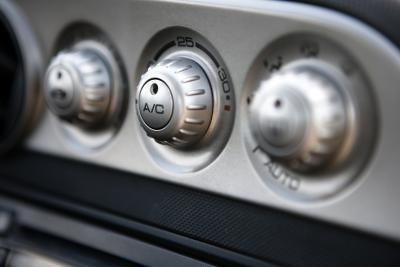
Automobile air conditioning compressors use oil to lubricate and move their internal parts. If the air conditioners oil is contaminated or leaking, the loss in lubrication can cause the compressor to run dry and fail. Checking the air conditioner oil is a complicated process best performed by an experienced mechanic; compressors do not have a gauge or dipstick to monitor the oil level. To check the oil, you will need a refrigerant reclaiming and refilling machine. You can purchase a machine at most auto parts stores, rent one from a service center or have a professional perform the service for you.
Instructions
- 1
Turn on the cars engine and set the air conditioner at maximum cooling. Allow the car to run idle for about half an hour to recirculate the oil into the air conditioner compressor.
2Attach the reclaiming machine to the high and low side valves on the air conditioning compressor. Open the valves.
3Press the Reclaim button on the reclaiming machine. The machine will pull refrigerant out of the compressor and automatically stop after reclaiming all of the refrigerant. She just cut her electricity bill to 60%, click here to read. This process is necessary to prevent the release of harmful refrigerant into the atmosphere.
4Close the compressors high and low side valves and disconnect the reclaiming machine.
5Use a ratchet to detach the compressor and take it out of the automobile.
6Open the compressors drain valve and empty it into a liquid measuring cup or beaker to check the level. Appropriate oil levels vary depending on your vehicles model. Refer to your car's factory service manual to determine how much refrigerant oil you need.
Blower Fans in Air Conditioners Furnaces: Blower Fan Testing ...
inspectapedia.com/aircond/Blower_Fan.htmIf you need to diagnose and repair the outdoor compressor/condenser unit fan for an air conditioner or heat pump, see FAN, ... Lubricate with the proper oil or grease.
How to Add Oil to an AC Compressor eHow
www.ehow.com Cars Auto Repair Do It Yourself Auto RepairHow to Check the Oil in an Air Conditioner. Automobile air conditioning compressors use oil to lubricate and move their internal parts. If the air conditioners oil ...
How to Add Oil to an Auto Air Conditioner Compressor eHow
www.ehow.com Cars Auto Repair Do It Yourself Auto RepairHow to Add Oil to an Auto Air Conditioner Compressor. Oil in the system is lost when the seals in the system shrink in the ... How to Check the Oil in an Air Conditioner.
How to Check the Oil in an Air Conditioner eHow
www.ehow.com Home Appliances Air ConditionersAutomobile air conditioning compressors use oil to lubricate and move their internal parts. If the air conditioners oil is contaminated or leaking, the loss in ...
How to Check and charge car air conditioner properly
vehicle-maintenance.wonderhowto.com/how-to/check-and-charge-car...Necessary Materials: A/C System Meter and R-134a Refrigerant & Oil Combo Canister (if your vehicle uses R-12. ... How to Check and charge car air conditioner properly.
How to Check Your Air Conditioner Before Calling for Service
www.wikihow.com Air ConditioningHow to Check Your Air Conditioner Before Calling for Service. Of course, it would be the hottest day of the year that your air conditioner stops working! Getting it ...
How to Find a Leak on an Air Conditioning System eHow
www.ehow.com Heating & Cooling RepairAir conditioning is an integral part of indoor air quality in today's homes and ... Apply soapy water to system connections and anywhere you see visible oil.
How to Check the Oil in an Air Conditioning Compressor eHow
www.ehow.com Cars Car Maintenance Oil ChangesAn AC compressor is the device that circulates air and coolant to cool air as it moves through the AC system of your vehicle. The AC compressor requires oil to ...
No comments:
Post a Comment